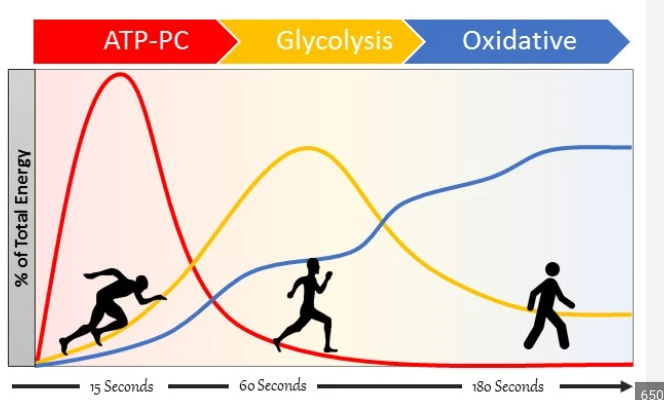If you’re just a gym bro you may have never read about energy systems like us exercise science nerds. Not all cardio is created equally. Intensity, duration, and mode (run, bike, swim, etc) will all have an influence on the adaptation you get from your cardio.
Aerobic training (AT) and cardio are often used interchangeably. AT leads to adaptations such as:
⬆️ Plasma, Myoglobin, & Hemoglobin Cell Volume
⬇️ Resting Heart Rate & ⬆️ Vagal Tone
⬇️ Blood Pressure
⬆️ Heart Size (Left Ventricle)
⬆️ Mitochondrial Density
⬆️ Capillary Density
⬆️ Aerobic Energy System Enzymes
These adaptations allow your cardiovascular (CV) system to transport oxygen more efficiently throughout your body and to use a larger proportion of that oxygen for energy production. Oxygen is transported in the blood stream so it only make sense that AT would improve ways to shuttle oxygen to your cells energy factories (mitochondria).
This article won’t go into glycolysis or biochemistry. Instead, I love the way Opex outlines the energy systems. It’s simple and gives tangible ways for you to develop a well rounded CV system.
Brief lesson for those unfamiliar with bioenergetics. Energy systems are active at all times to various degrees and respond to predicted energy needed.
High Intensity Activity / First 15 Seconds
We begin with high intensity activity using phosphocreatine (ATP-PC system) for energy
Moderately High - High Intensity
Moderately high to high activity uses carbohydrates and creatine for energy.
Low Intensity
Low Intensity activity uses primarily fat and carbohydrates for energy. The lower the intensity, the greater ratio of fat is used for the activity.
What energy currency you use for activity is dependent on intensity. It can also be affected by your mental state or arousal. As one system fatigues, it will tap into the next system more. One really important note, your aerobic (oxidative) system is always running in the background and helps to replenish the ATP-PC and Glycolytic/anaerobic systems. This is why building an aerobic base is crucial for any conditioning goals.
Gain
This is the primary system for lifting weights although it is also exhibited in sports with bursts of high intensity like combat sports, football, basketball, tennis, and more. This system is alactic, so you won’t have a build up of lactate in the muscle. This mean spending less then 5-10 seconds in the activity and ideally with high power output.
Gain Workout A
Sumo Deadlift with chains 10 x 1
Every Minute on The Minute
Gain Workout B
Assault Bike Sprint x 5 seconds
Assault Bike Recovery 2:00
6 Rounds
Pain
Pain is an unsustainable effort. This sucks. Unlike the gain system where lactate is minimized, we want to maximize lactate output in the pain system. Pain is where a lot of athletes will gain performance benefits especially for things like VO2 max.
You want a good base of strength before beginning any pain training. Otherwise you won’t reap the benefits of a large lactate dump. I’d also recommend less technical movements. This is not a great system to train technical movements like a deadlift or split jerk.
Pain Workout A
50 Calorie Row for Time Rest 3 :00
30 Calorie Row for Time Rest 3:00
10 Calorie Row for Time
Pain Workout B
Assault Bike x 30 sec at 80-90% max intensity
Assault Bike x 3:00 Recovery Pace
3-4 Rounds. You can take a 4-8 min rest after those rounds and hit it again if needed.
Sustain
Long slow distance and low intensity activity like walking on an incline treadmill or going for a bike ride. This is the pace your neighborhood joggers will live in. It’s not fast.
Sustain Workout A Mixed Modal
Perform the following at a sustained pace:
Bike x 5:00
Ski Erg x 4:00
Bike x 3:00
Ski Erg x 2:00
Bike x 1:00
Sustain Workout B
30 min Run at 70-75% of heart rate max (HRM)
Sustain Workout C
Rower x 10:00
Bike x 10:00
Ski Erg x 10:00
All at 70-75% of HRM
Ideally, you work all energy systems to get the best results in health and performance. Word to the wise, don’t start any workouts with pain. Unless that’s the only thing you’re doing. Begin with either gain (strength training, speed, or power development) and move into sustain or pain. You don’t want to completely set yourself on fire with a pain style of training only to the hit heavy back squats for reps immediately afterward. That’s just poor program design.
Use these concepts to properly categorize your training and to better manage recovery. Let me know in the comments if you have any questions.
Strength Club Training
Block 3 Week 1
We have 2 more weeks on this training block before we shift to another training cycle. Since summer is approaching it’ll likely be something a little more fun with Finishers and pump work included.
Get The Full Week Below ⬇️⬇️⬇️
Keep reading with a 7-day free trial
Subscribe to Weekly Flex to keep reading this post and get 7 days of free access to the full post archives.










